After 30 years of historically low inflation, the last two years have been a very different story. After almost 15 years of low interest rates and stable price rises, central banks have been trying hard to limit the bulging basket of price rises. Will the latest data on inflation provide a sign that the medicine is finally starting to work? Our Senior Investment Specialist, Simon Durling, shares his thoughts in this week’s State of Play.
Key highlights from this week’s State of Play
- Latest inflation data
- Headline or core?
- Secondary effects
- Market update
Latest inflation data
The latest figures from the Office for National Statistics (ONS) show the Consumer Price Index (CPI) fell from 10.1% to 8.7% in the year to April, but much less than expected.1 This will place added pressure on the Bank of England to continue to increase interest rates when they next meet in June, as food prices remain stubbornly high and core inflation, which excludes energy and food, increased from the month before from 6.2% to 6.8%.1
The first significant fall in the headline rate since higher inflation re-emerged 2 years ago was driven mainly by sharp falls in gas prices when compared to a year ago. While gas prices only fell by 1% between March and April this year, they rose over 66% over the same two months this time last year.1 In recent months, the cost of heating and powering our homes has fallen, with the average bill for a typical household predicted to fall to £2,0742 when the next energy price cap is implemented on 1 July by the energy watchdog OFGEM.
CPI annual rate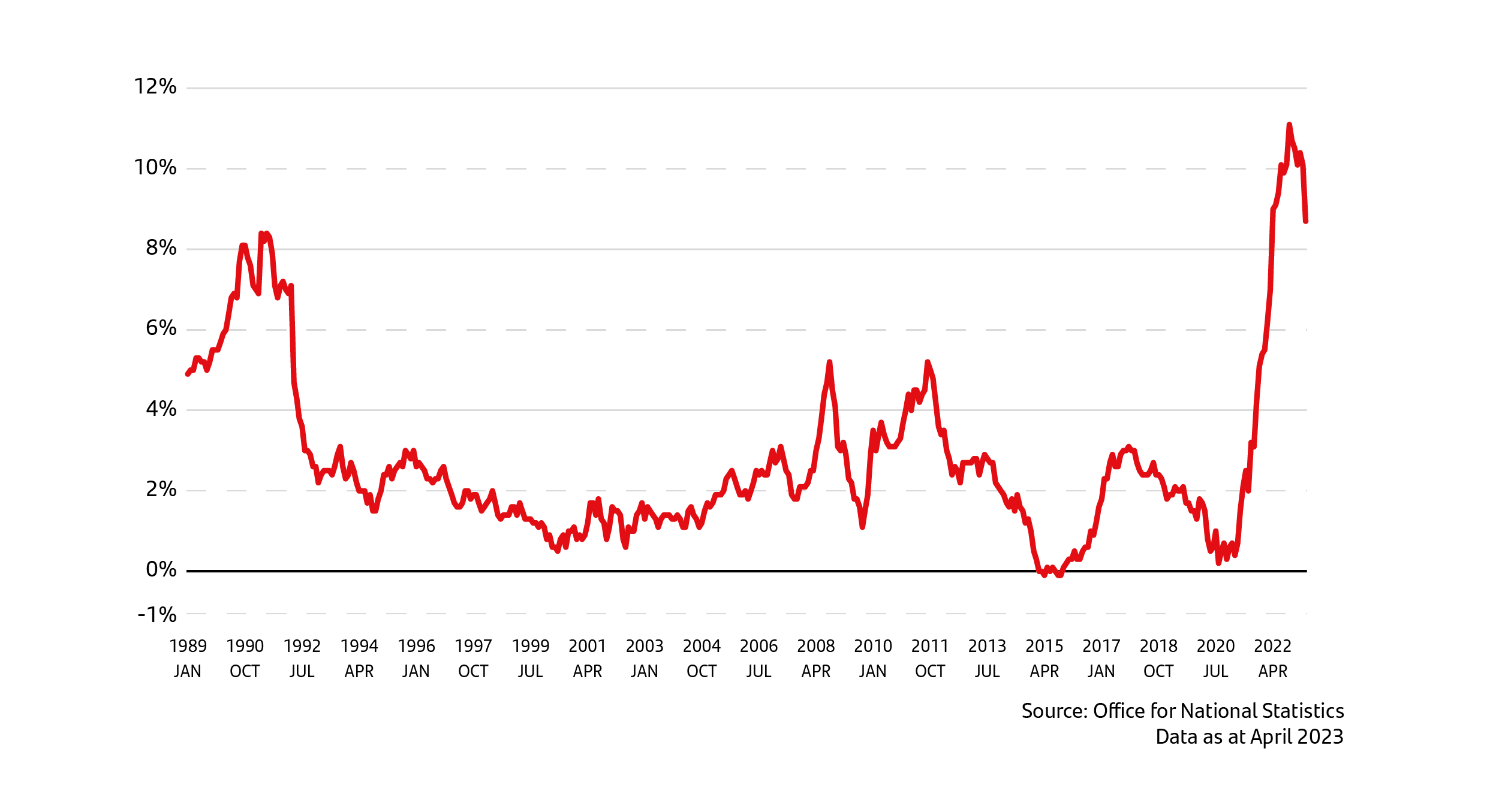
While, households will be relieved to see their energy bills coming down, these falls have been offset to a certain extent by the continued surge in food price inflation. Food and non-alcoholic beverage prices continued to rise in April and contributed to rising prices, however, the annual inflation rate of food and non-alcoholic beverages eased slightly by 0.1% but remains at near record highs of 19.1% in the year to April 2023.1
Contributions of housing components to the annual CPIH inflation rate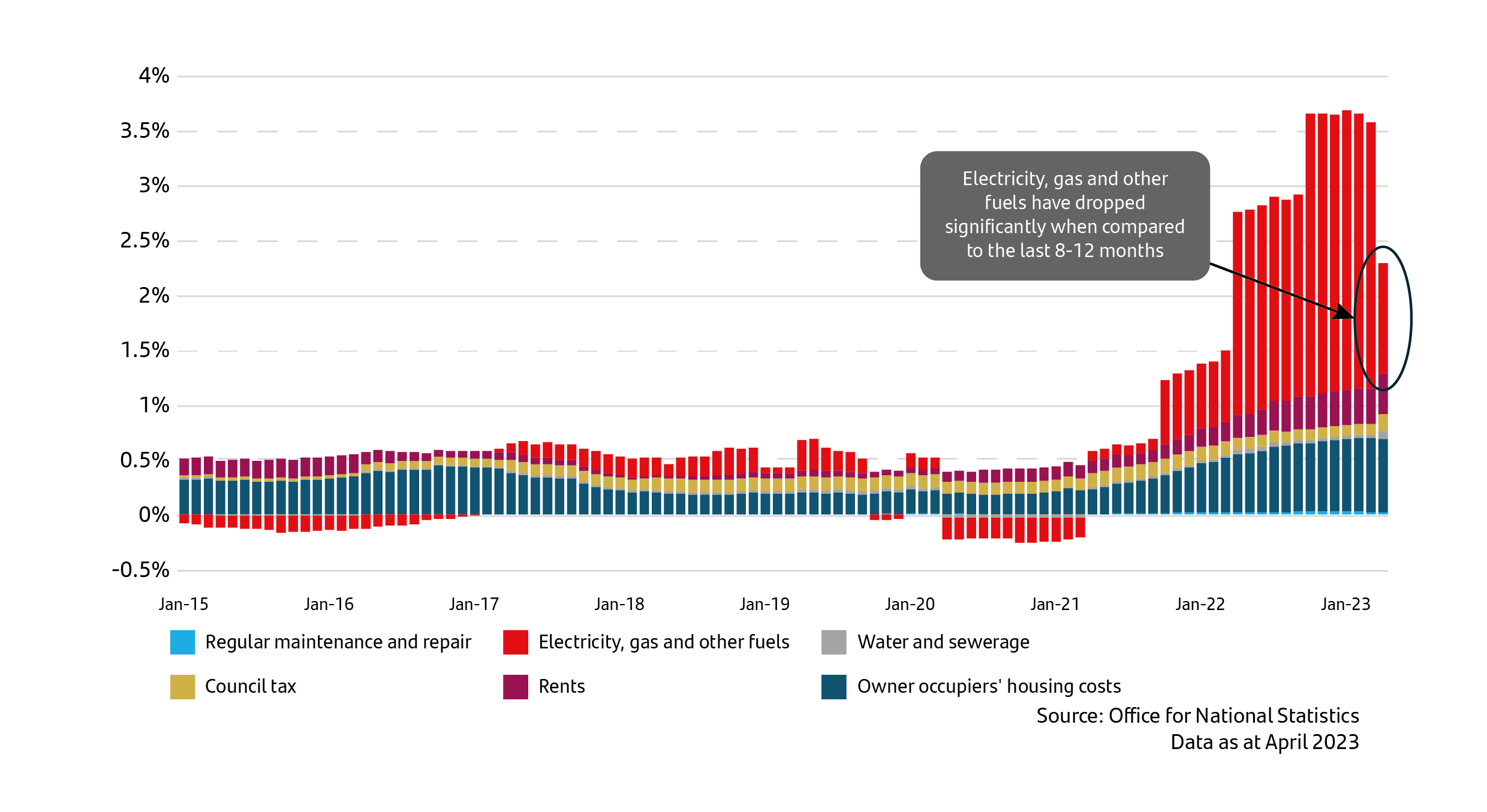
Headline or core?
One aspect of the price rises that the Bank of England can’t ignore is the difference between the headline rate and what is known as core inflation. So, what are the key differences between these calculations and why is this potentially important?
Headline inflation, the most familiar to the public, is the Consumer Price Index (CPI). This is a weighted basket of goods and services that gauges the change in price of the goods and services we buy, apportioning a greater influence on the change to the goods we consume more often based on our spending patterns. It compares the price now of each good or service with that of 12 months ago before arriving at the annual rate of increase. This is crucial in understanding the drivers of price rises, the impact on consumer budgets, and the potential effect on future economic growth. The inflation basket is updated regularly to reflect the changes in these spending patterns to better reflect overall consumption in the economy.
What is a weight?
Consumer price inflation is the rate at which the prices of goods and services rise or fall and is estimated using price indices. One way to understand a price index is to think of a large shopping basket containing goods and services typically bought by all households. The price index estimates changes to the total cost of this basket by calculating the average price change of the items within the basket. Households spend more on some goods and services than others. For example, a 10% increase in the price of petrol will have a much bigger impact on the basket than a similar rise in the price of tea. For this reason, the components of price indices are weighted using the amount we all spend on these items as consumers, to ensure that it reflects the relative importance of the various items in the average shopping basket.
Source: Office for National Statistics
Core inflation measures the changes in the price of goods and services, excluding food and energy. In the latest report from the ONS released yesterday, they quote, ‘Annual core CPI rose by 6.8% in the year to April 2023, up on March's rise of 6.2% and is at its highest level since March 1992. The CPI all goods index increased by 10.0% in the year to April 2023, down from 12.8% in March. The CPI all services index increased by 6.9% in the year to April 2023, up from 6.6% in March, placing it at its highest level since March 1992.’1
The importance of looking closer at the inflation data and comparing the headline rate with core inflation is to understand whether the medicine of interest rate rises is beginning to work. The importance of identifying the difference between core and headline inflation rates lies in understanding how difficult it may be for the bank to restore inflation to its long-term target of 2%.
Comparing headline and core inflation
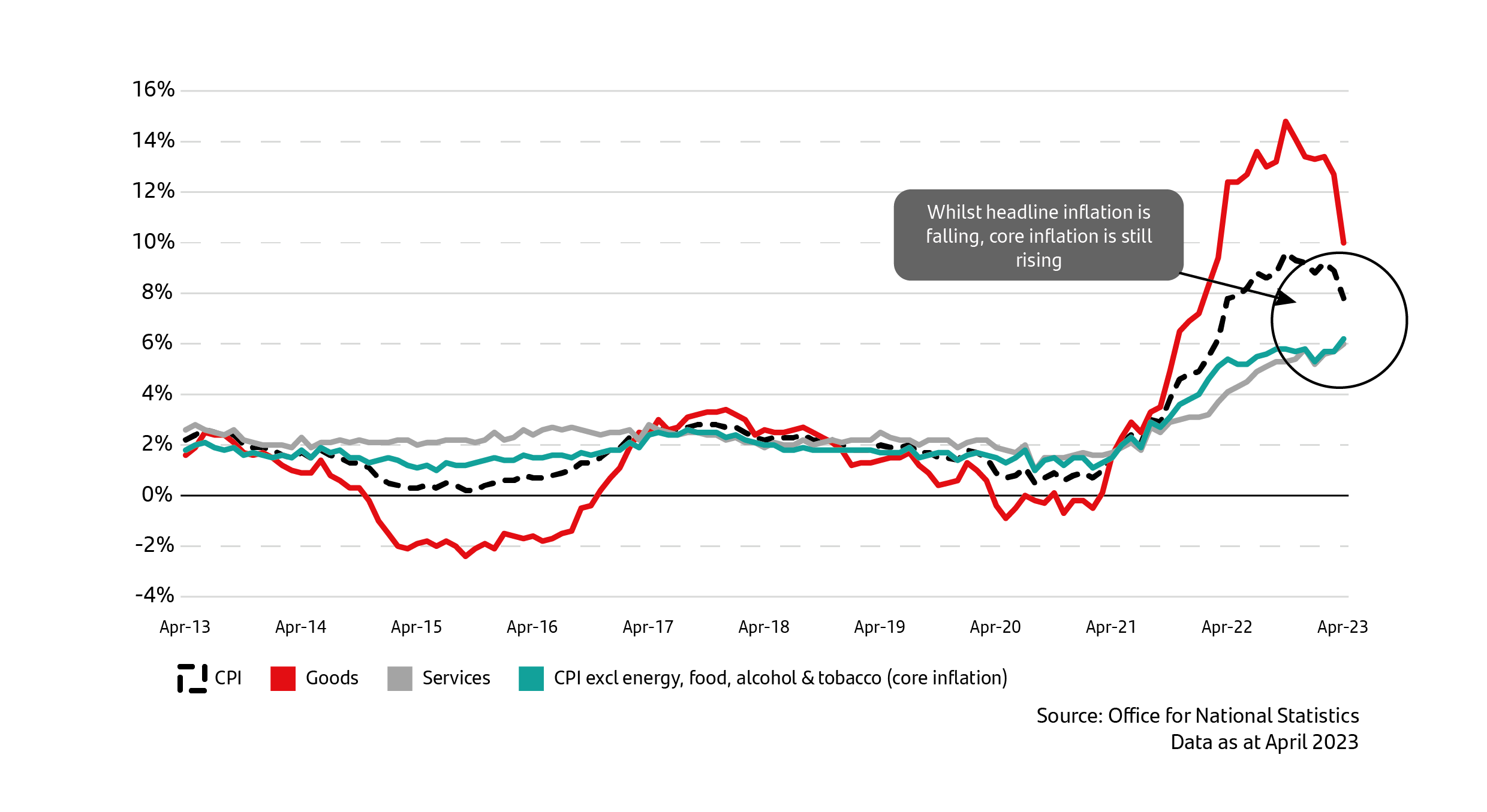
Secondary effects
The Bank of England Monetary Policy Committee, which meets on 22 June to decide on whether to increase interest rates, will be pleased to see headline inflation beginning to fall. However, one of their ongoing concerns is the level at which pay rises are being agreed upon in both the public and private sectors. What is known as ‘secondary effects’, where strong wage rises cushion the blow of higher interest rates and delay the slowdown in economic demand, causing inflation to remain higher for longer.
When individuals start to receive higher wages, despite the increase in prices, they initially feel better off and continue to spend, using all or a proportion of their higher wages. This stimulates further demand and is normally passed on by producers, who will pay higher wages for their employees but will pass much of this rise on in the price of the goods and services they offer, pushing up prices further. This same spiral happened during the 1970’s3, which prompted what is known as stagflation – low or zero economic growth and very high inflation over a sustained period – making everyone worse off.
The Governor of the Bank of England, Andrew Bailey, admitted this week to a committee of MPs that the bank had lots to learn from the mistakes it has made in misjudging the true scale of inflation this time around, but cited that the circumstances both during and post-pandemic were unprecedented and the benefit of hindsight is not at their disposal in policymaking decisions.4
Market update
Market sentiment remains dominated by concerns about negotiations between both sides of the political divide in the US on agreeing a change to the debt ceiling to avoid the US defaulting on its vast debts. The deadline of 1 June for agreement is fast approaching, focusing minds on the financial and reputational risks. This short story or political theatre play has been played out on many occasions over recent years as politicians use the deadline to leverage compromise on their political agenda. There have been occasions where state workers have been laid off for a short period and government buildings and national parks close while negotiations are concluded. Most market participants don’t believe both main political parties will allow the US to default on its debt obligations, but uncertainty hangs in the air, nonetheless.
The two biggest winners from last week were the NASDAQ, which rose 3.79% and the Japanese stock market, which rose 2.78%. The other big mover last week and for much of this week has been UK Gilt Yields, which, in response to expectations that further rate rises are inevitable, rose by 0.25%, to take the yield above 4% for the first time since October last year.5 Markets remain nervous and uncertain, waiting to see how central banks navigate the next round of rate meetings in June.
Santander Asset Management UK receives regular feedback about the content of State of Play, and where possible, we try to accommodate suggestions. This week’s update contains market data reflecting a wide range of share indices, bond yields, currencies and commodities. It is intended only as reference point to help readers compare the narrative with market values looking back at the previous trading week. This captures data at the close of business on the preceding Friday and compares it with the change from the previous trading week. The data is sourced by Santander Asset Management UK’s investment team using Eikon.
The value of seeking guidance and advice
It is important to seek advice and guidance from a professional financial adviser who can help to explain how to build an appropriate financial plan to match your time horizons, financial ambitions, and risk comfort. If you already have a plan in place, or have already invested, it is important to allocate time to review this to ensure this remains on track and appropriate for your needs.
A week in the markets
Performance
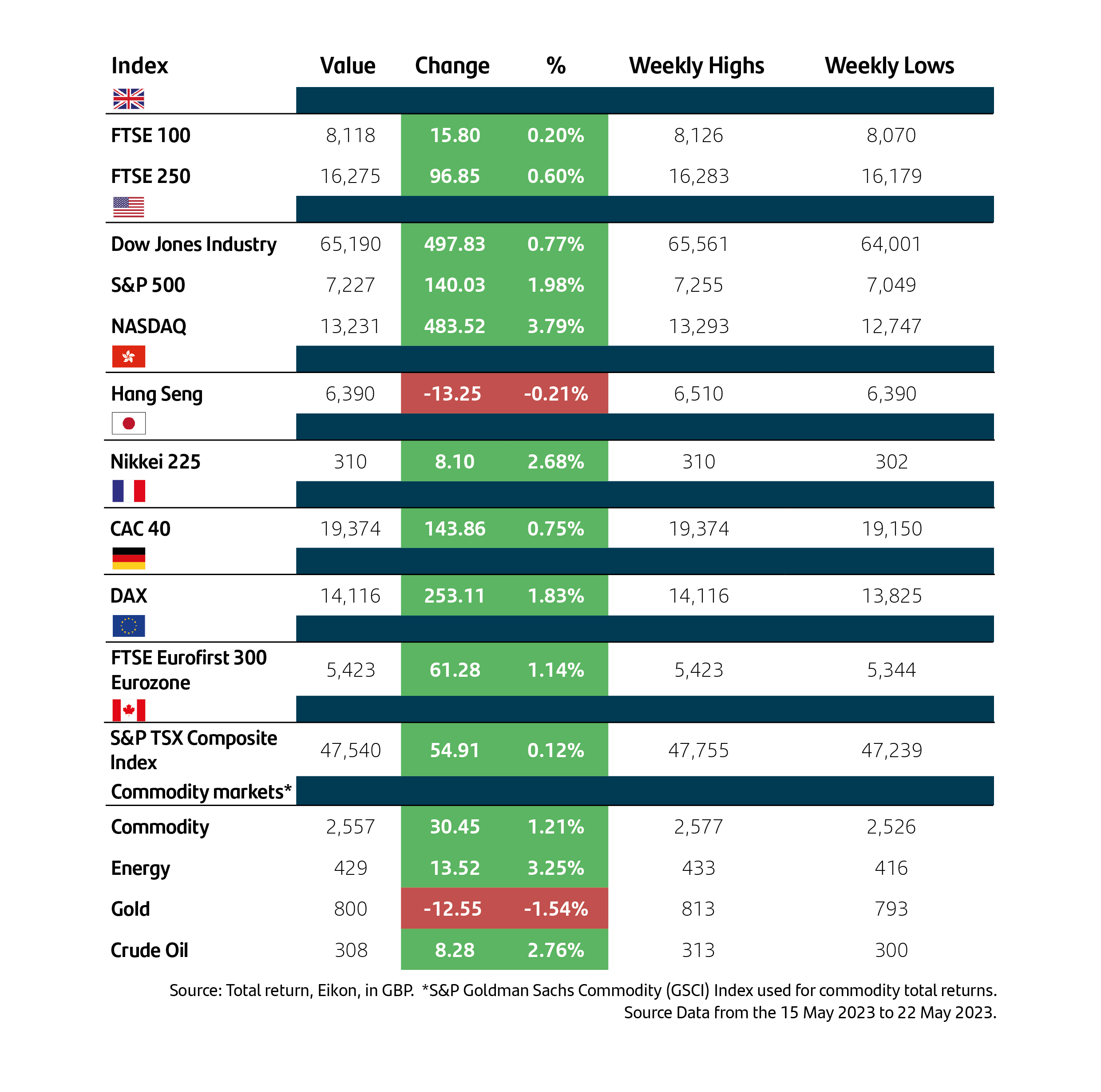
10-year bond yields
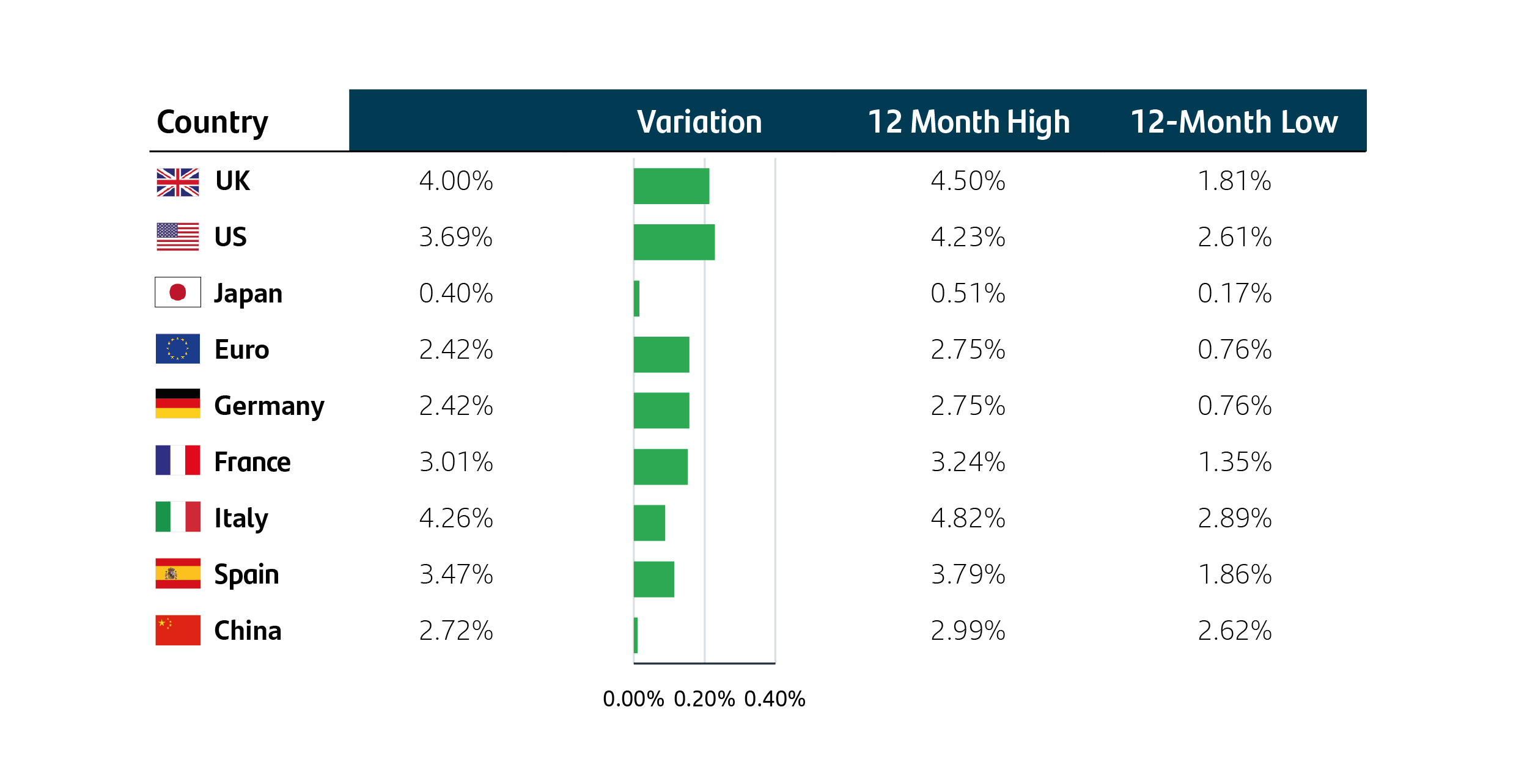
Currencies


Investing can feel complex and overwhelming, but our educational insights can help you cut through the noise. Learn more about the Principles of Investing here.
Note: Data as at 25 May 2023. 1Office for National Statistics (ONS), 24 May 2023. 2Ofgem, 25 May 2023. 3AP News, 26 May 2022. 4The Times, 24 May 2023. 5Investing.com, 24 May 2023
Important information
For retail distribution. This document has been approved and issued by Santander Asset Management UK Limited (SAM UK). This document is for information purposes only and does not constitute an offer or solicitation to buy or sell any securities or other financial instruments, or to provide investment advice or services. Opinions expressed within this document, if any, are current opinions as of the date stated and do not constitute investment or any other advice; the views are subject to change and do not necessarily reflect the views of Santander Asset Management as a whole or any part thereof. While we try and take every care over the information in this document, we cannot accept any responsibility for mistakes and missing information that may be presented.
All information is sourced, issued and approved by Santander Asset Management UK Limited (Company Registration No. SC106669). Registered in Scotland at 287 St Vincent Street, Glasgow G2 5NB, United Kingdom. Authorised and regulated by the FCA. FCA registered number 122491. You can check this on the Financial Services Register by visiting the FCA’s website www.fca.org.uk/register




